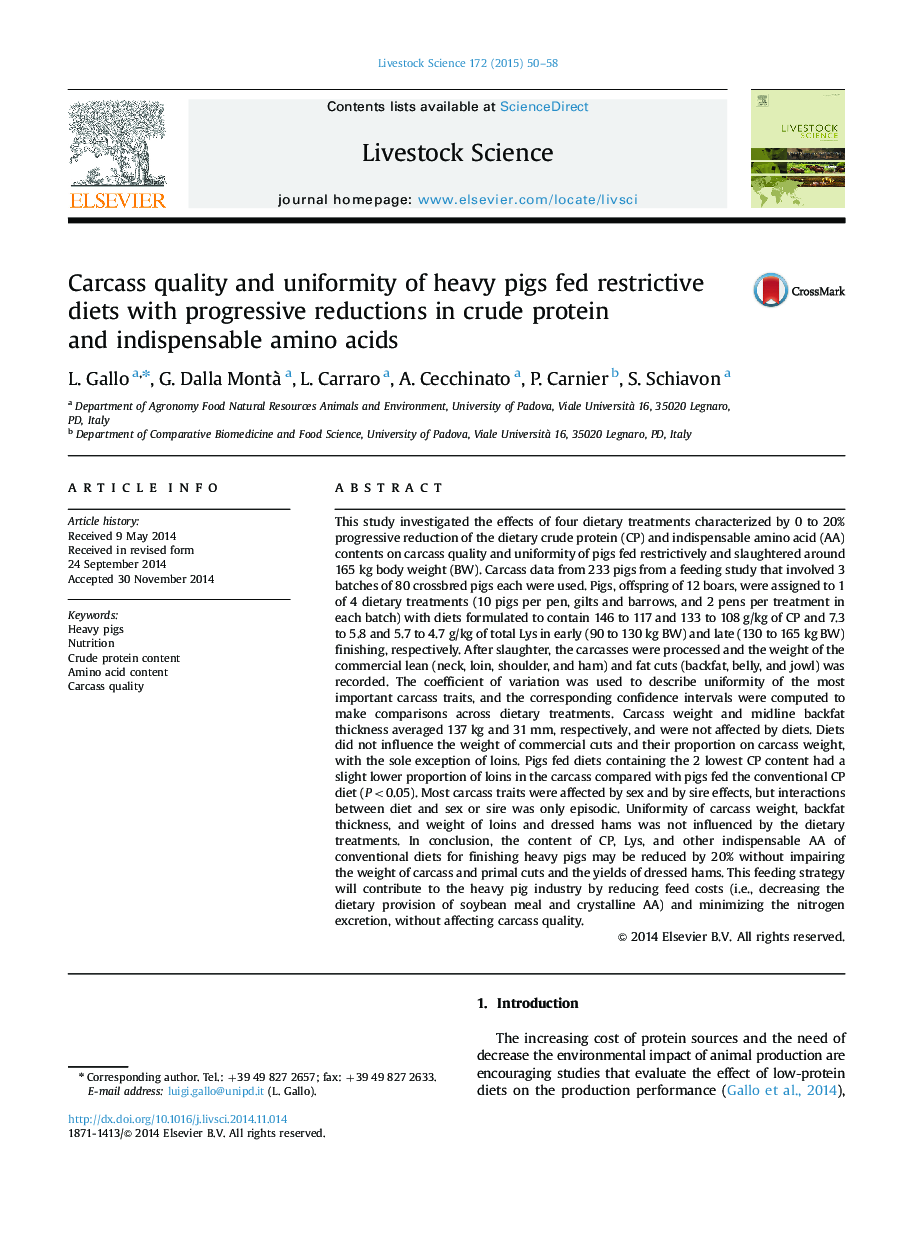| کد مقاله | کد نشریه | سال انتشار | مقاله انگلیسی | نسخه تمام متن |
|---|---|---|---|---|
| 8502182 | 1553960 | 2015 | 9 صفحه PDF | دانلود رایگان |
عنوان انگلیسی مقاله ISI
Carcass quality and uniformity of heavy pigs fed restrictive diets with progressive reductions in crude protein and indispensable amino acids
ترجمه فارسی عنوان
کیفیت لاشه و یکنواختی خوک های سنگین تغذیه رژیم های محدود کننده با کاهش مداوم پروتئین خام و اسیدهای آمینه ضروری
دانلود مقاله + سفارش ترجمه
دانلود مقاله ISI انگلیسی
رایگان برای ایرانیان
کلمات کلیدی
خوک های سنگین تغذیه، محتوای پروتئین خام محتوای آمینو اسید، کیفیت لاشه،
موضوعات مرتبط
علوم زیستی و بیوفناوری
علوم کشاورزی و بیولوژیک
علوم دامی و جانورشناسی
چکیده انگلیسی
This study investigated the effects of four dietary treatments characterized by 0 to 20% progressive reduction of the dietary crude protein (CP) and indispensable amino acid (AA) contents on carcass quality and uniformity of pigs fed restrictively and slaughtered around 165Â kg body weight (BW). Carcass data from 233 pigs from a feeding study that involved 3 batches of 80 crossbred pigs each were used. Pigs, offspring of 12 boars, were assigned to 1 of 4 dietary treatments (10 pigs per pen, gilts and barrows, and 2 pens per treatment in each batch) with diets formulated to contain 146 to 117 and 133 to 108Â g/kg of CP and 7.3 to 5.8 and 5.7 to 4.7Â g/kg of total Lys in early (90 to 130Â kg BW) and late (130 to 165Â kg BW) finishing, respectively. After slaughter, the carcasses were processed and the weight of the commercial lean (neck, loin, shoulder, and ham) and fat cuts (backfat, belly, and jowl) was recorded. The coefficient of variation was used to describe uniformity of the most important carcass traits, and the corresponding confidence intervals were computed to make comparisons across dietary treatments. Carcass weight and midline backfat thickness averaged 137Â kg and 31Â mm, respectively, and were not affected by diets. Diets did not influence the weight of commercial cuts and their proportion on carcass weight, with the sole exception of loins. Pigs fed diets containing the 2 lowest CP content had a slight lower proportion of loins in the carcass compared with pigs fed the conventional CP diet (P<0.05). Most carcass traits were affected by sex and by sire effects, but interactions between diet and sex or sire was only episodic. Uniformity of carcass weight, backfat thickness, and weight of loins and dressed hams was not influenced by the dietary treatments. In conclusion, the content of CP, Lys, and other indispensable AA of conventional diets for finishing heavy pigs may be reduced by 20% without impairing the weight of carcass and primal cuts and the yields of dressed hams. This feeding strategy will contribute to the heavy pig industry by reducing feed costs (i.e., decreasing the dietary provision of soybean meal and crystalline AA) and minimizing the nitrogen excretion, without affecting carcass quality.
ناشر
Database: Elsevier - ScienceDirect (ساینس دایرکت)
Journal: Livestock Science - Volume 172, February 2015, Pages 50-58
Journal: Livestock Science - Volume 172, February 2015, Pages 50-58
نویسندگان
L. Gallo, G. Dalla Montà , L. Carraro, A. Cecchinato, P. Carnier, S. Schiavon,
